 Needs Pictures: 0
Needs Pictures: 0
Results 1 to 14 of 14
Thread: Drill Press Table
-
10th December 2019, 03:28 AM #1
 Drill Press Table
Drill Press Table
A couple of weeks ago I took advantage of a Black Friday sale and purchased a Nova Voyager drill press for a great discount. This replaced a Taiwanese model I had for 25 years. Yeah, I know this machine is OTT, but it is an amazing tool. For those who are not familiar with the Voyager, it is a computerised, variable speed drill press with a 2 hp direct drive motor (240v). I have already used it to determine the ideal speed for a selection of forstner bits, and then drill to a preset depth, and stop automatically at that depth.
Putting it together was .. uh ... a little scary. The motor section is extremely heavy, and I was concerned that I would drop it in my usual clumsy fashion. Anyway, it was put together without mishap. A Nova fence was one of the freebees thrown in ...

Nova recommend that one not use a mobile base, however I need to do so since my machines occupy one side of a double garage, and some machines need to be mobile. The drill press is one. The ideal mobile base is as low to the floor as possible. A low centre of gravity is more stable, but also you do not want to raise the drill press up too much as the controls and computer screen may be moved out of your comfort zone.

Steel mobile base on lockable wheels ...

This post is more about the table I built for the drill press. Some may be able to use the ideas here. Most of the ideas are old hat, but there are a couple of novel ideas. My old drill press used nothing more exciting than a piece of plywood over the cast iron table. Somehow it was sufficient, although the work holding sucked ... and this is what I wanted to address here. Plus, the sacrificial board became chewed up and useless very quickly, and I had an idea to improve on this.
I was not crazy about the cast iron table as a work surface. For a top I found in my local salvage yard a 18" x 25" UHMW slab 30mm (1-1/4") thick. This is about as perfect a table top as one could get - it is very resistant to damage, and yet will not damage wood placed on it.
It planes without any tearout
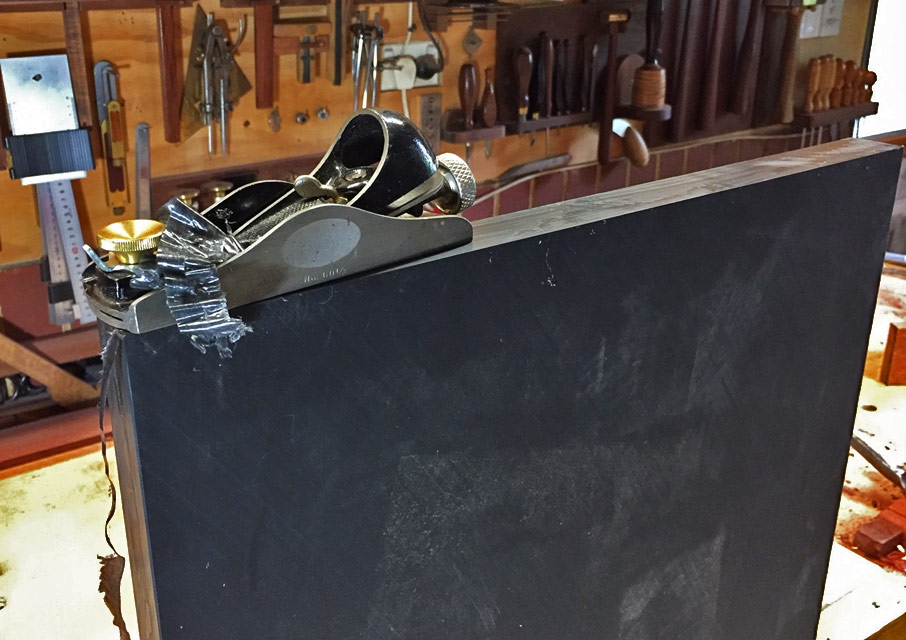
The first task was to dado in aluminium tracks for the fence and hold downs, and then to create a circular mortice for a sacrificial section ...
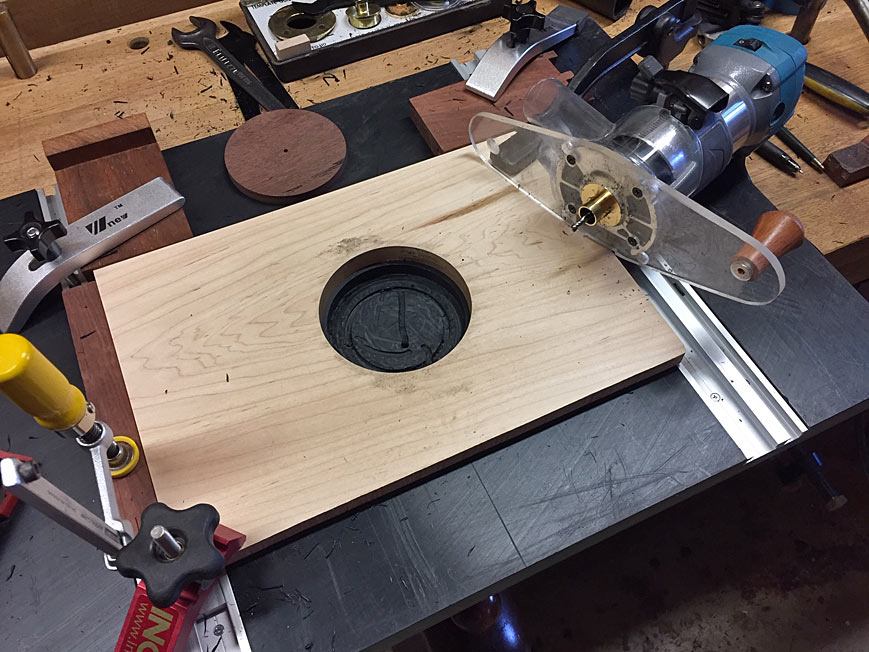
Using a power router to waste UHMW is an interesting experience - lots of plastic string everywhere, and dust control was not working well. The circular recess was time consuming and finicky. The template began as a 2" forstner cut hole. This was then progressively widened to 4" using a rebate and a flush cut bit in the router table. Finally, the template was used with a pattern cutter to create the circular recess, above.
The circular sacrificial disks are 1/2" thick MDF. I found it quicker to saw them fractionally oversize on the bandsaw, and then turn them on the lathe ...

Here now is the basic table ...
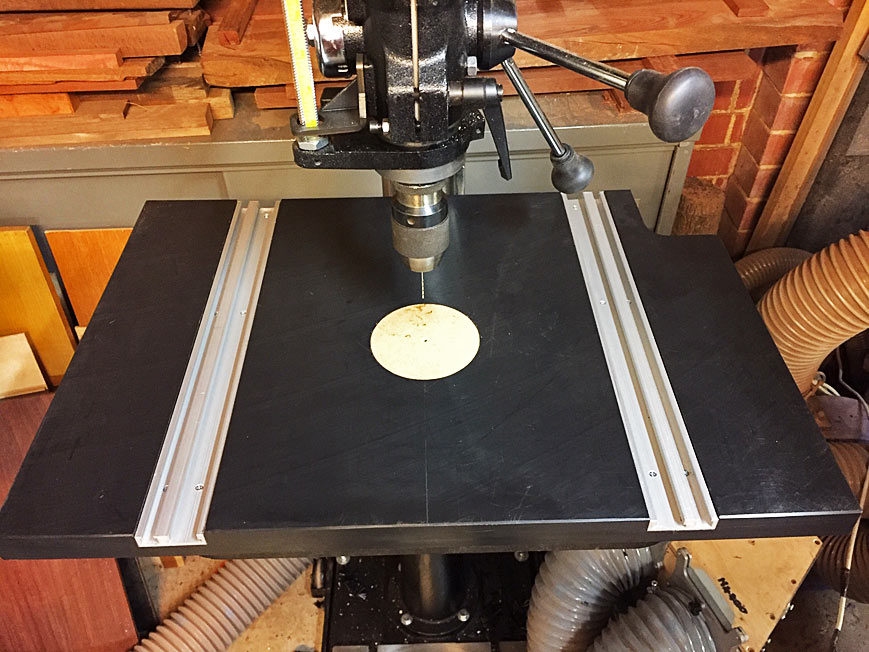
There is a cut out at the rear for the winder ...
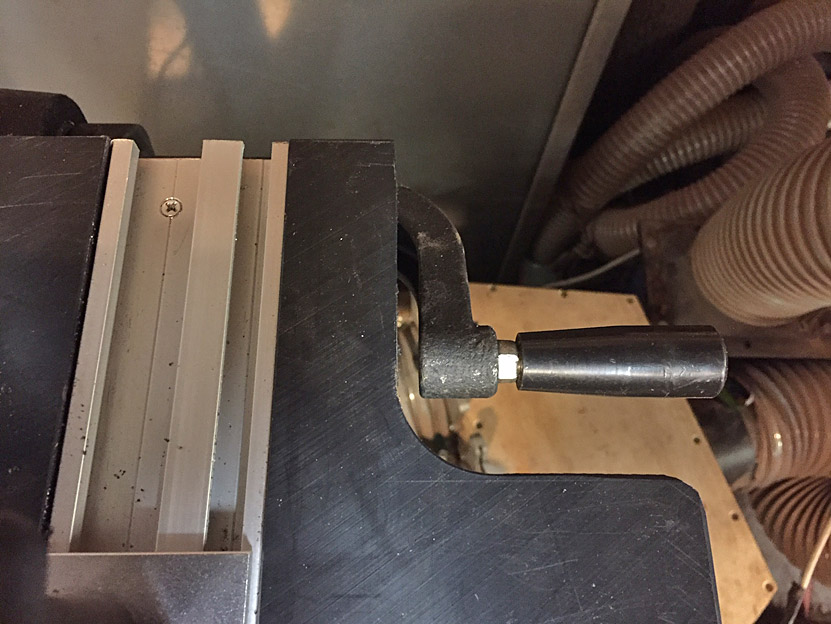
Now why did I choose a circular sacrificial section? I have seen many drill press tables using square sections. I cannot recall seeing any with round disks (unless it was dedicated to a sander, but that is not the same thing). The drill bit is not centred on the square. Instead, it is moved to the rear of the square. That way one can rotate the disk four times after it becomes holed. My objection to this design was that one only obtained four points, and as soon as one section became holed, it could no longer back up the drill.
Now a circular disk, on the other hand, has an infinite number of positions (infinite until the circle is completed). Just rotate as much as you need. More work to make, but better in the long run.
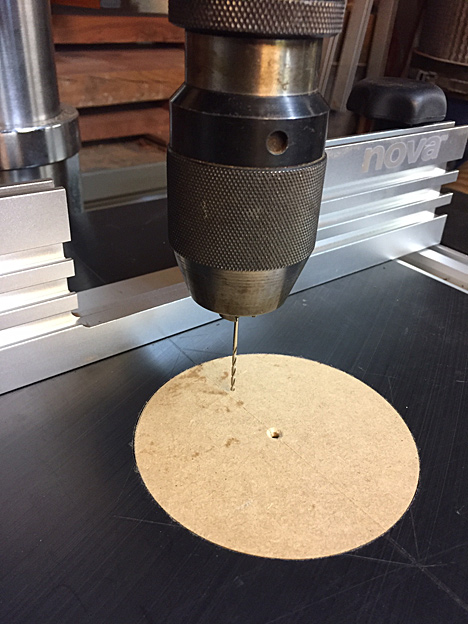
Here is the finished table ...
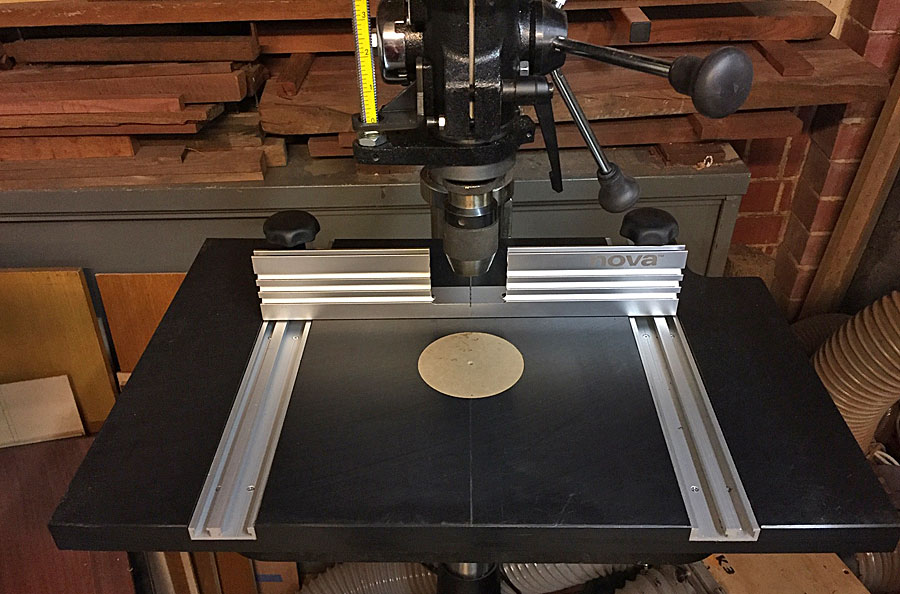
The Nova fence came with those twisty levers. They are useless ... difficult to achieve the ideal tautness and hard to get to behind the fence. I replaced them with the long knobs. These needed to be cut down by 3/4" to avoid fowling the downfeed handles.
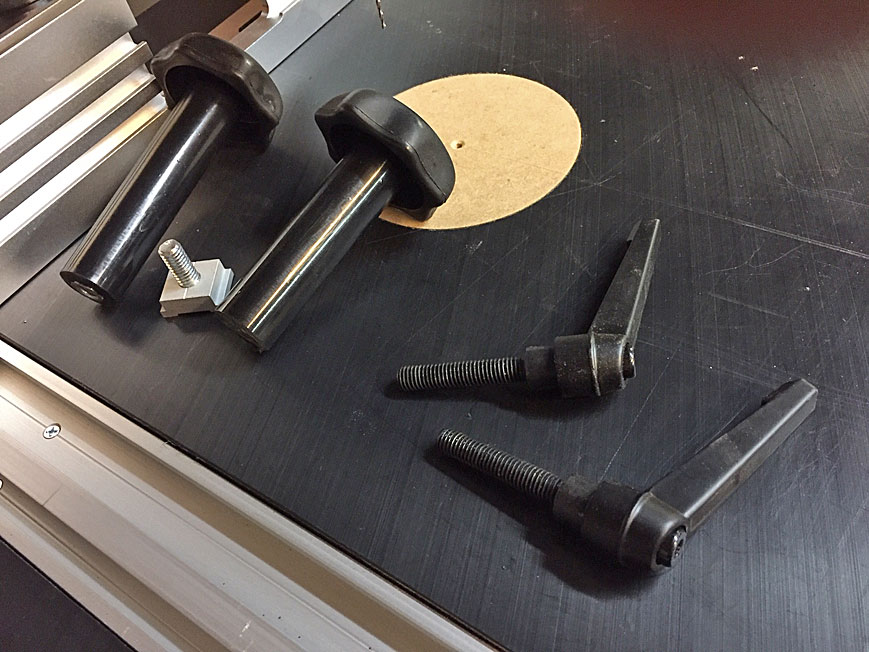
The tracks not only hold the fence, but also Incra hold downs ...
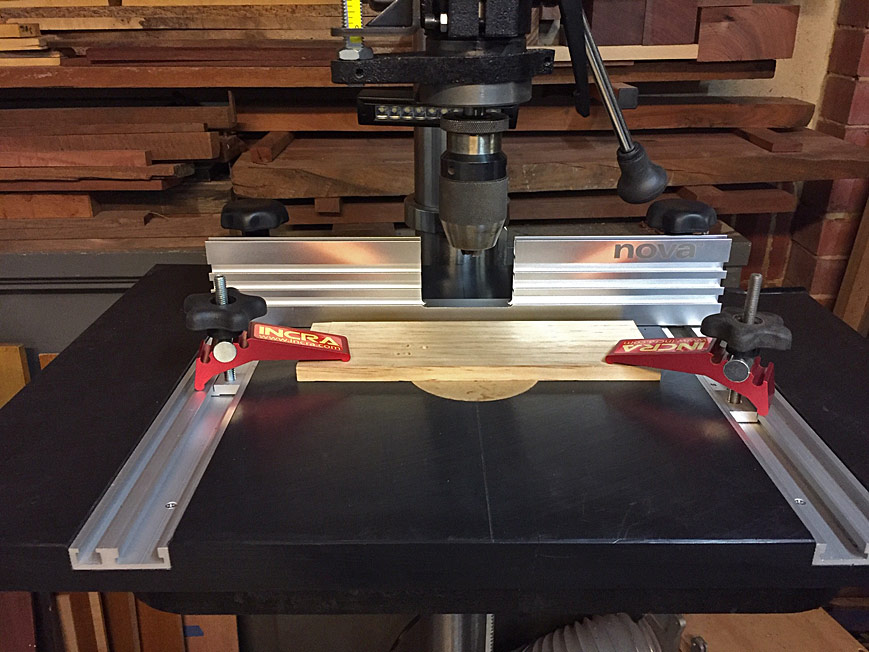
... and even the Micro Jig clamps for taller boards ...
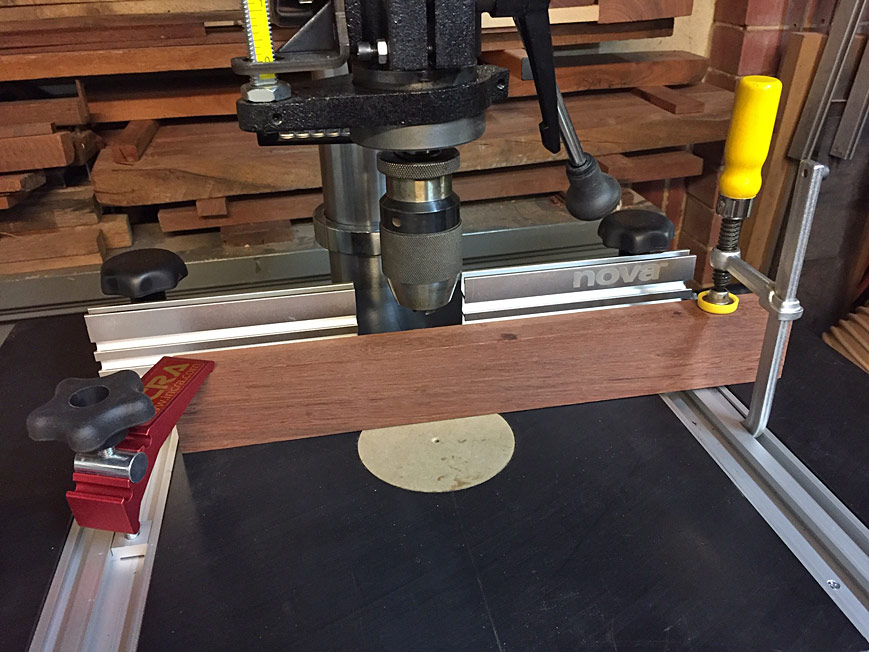
I hope there is something you can use.
Regards from Perth
DerekVisit www.inthewoodshop.com for tutorials on constructing handtools, handtool reviews, and my trials and tribulations with furniture builds.
-
10th December 2019 03:28 AM # ADSGoogle Adsense Advertisement
- Join Date
- Always
- Location
- Advertising world
- Posts
- Many
-
10th December 2019, 08:32 AM #2
 Senior Member
Senior Member











- Join Date
- Aug 2016
- Location
- Hervey Bay
- Age
- 46
- Posts
- 230

Looks great Derek, I recently acquired one of the small Bosch versions and the ability to set a precise depth and speed as well as not having to change belts are such handy features. I can only imagine the user friendliness on this machine is even greater.
-
10th December 2019, 08:56 PM #3
 SENIOR MEMBER
SENIOR MEMBER











- Join Date
- May 2018
- Location
- Melbourne
- Posts
- 507

Derek, is your table secured to the drill press table? If so, how?
Thanks
-
10th December 2019, 09:04 PM #4

You will recall in the original photo that the cast iron top has slots. I tapped in aluminium threads on the underside of the UHMW top, and then bolted it through the slots. It is secure and unobtrusive.
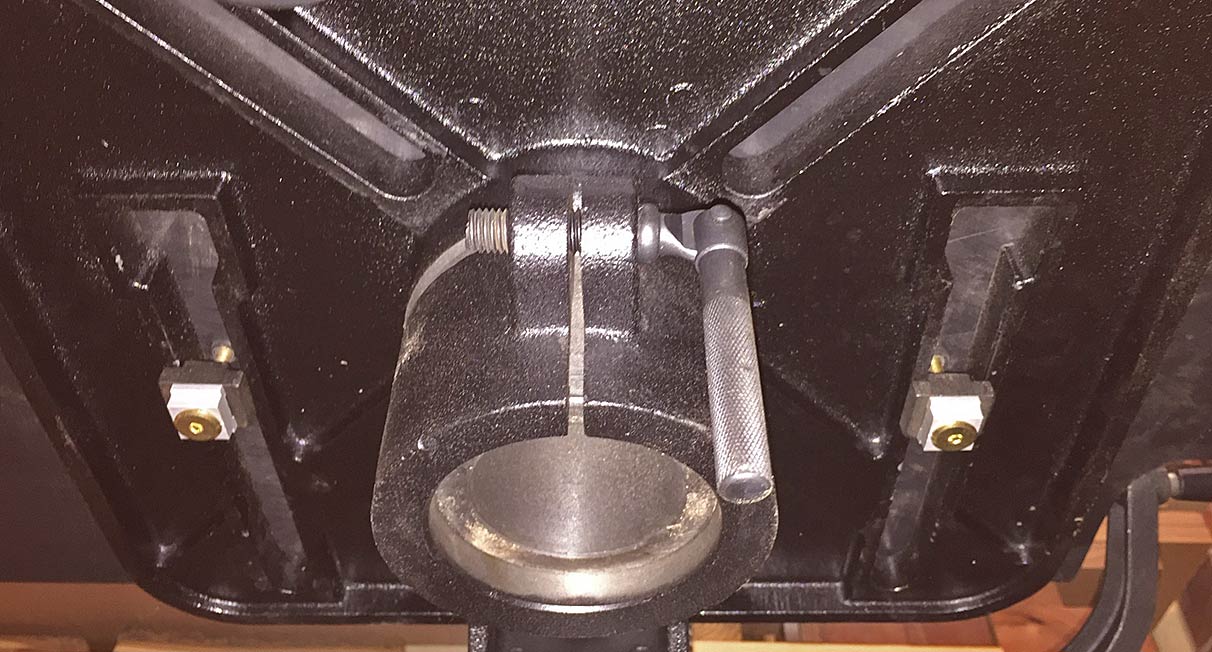
Regards from Perth
DerekVisit www.inthewoodshop.com for tutorials on constructing handtools, handtool reviews, and my trials and tribulations with furniture builds.
-
11th December 2019, 10:21 PM #5

I'm very jealous!

You could also cut the circular inserts using a circle cutter on your fancy drill press. (I did mention I was jealous, right? )
)
I bought a cheapie from Amazon (I think I paid $21 including shipping with Prime) and it does a creditable job all things considered.
I highly recommend you do NOT run it at the recommended maximum speed of 500 RPM. That is freaking scary! I ran it at the absolute minimum speed the drill press can do.
IMG_0307.jpg
A little bit of hand sharpening and I could get shavings in Radiata Pine!
-
11th December 2019, 11:49 PM #6

Thanks Mark

I've never used a circle cutter - don't own one.
Using the bandsaw to rough out, and then final turning in the lathe, was really quick and fairly effortless. I had planned to built a circle-cutting jig for the bandsaw, but this turned out to work well.
Regards from Perth
DerekVisit www.inthewoodshop.com for tutorials on constructing handtools, handtool reviews, and my trials and tribulations with furniture builds.
-
12th December 2019, 12:34 AM #7
 Visit www.inthewoodshop.com for tutorials on constructing handtools, handtool reviews, and my trials and tribulations with furniture builds.
Visit www.inthewoodshop.com for tutorials on constructing handtools, handtool reviews, and my trials and tribulations with furniture builds.
-
12th December 2019, 02:37 AM #8

Hi Derek,
Nice work on the DP table.
I have the Nova Voyager on the shortlist for my next major acquisition and would love to hear your opinion of it overall once you have given it a fair run.
Have you taken any measurements on the runout on the quill and chuck? I am hoping that for the price that they would be better than my H&F one I am using now,although it is pretty good.
I have only seen it for sale in Australia by Carbatec who have had it marked down by $300 for the past few months. Was there a Black Friday sale price that I missed or was that it?I got sick of sitting around doing nothing - so I took up meditation.
-
12th December 2019, 03:13 AM #9

Hi Doug
I have replaced the quill and chuck with a 13mm keyless chuck, one I used for several years on my previous drill. How much run out does it have? No idea. I'll check it out at some stage, but the little use it has had does not indicate any issues.
The purchase was made from Carbatec: $300 off the list price, and the fence ($100) thrown in.
Regards from Perth
DerekVisit www.inthewoodshop.com for tutorials on constructing handtools, handtool reviews, and my trials and tribulations with furniture builds.
-
12th December 2019, 09:31 AM #10
 GOLD MEMBER
GOLD MEMBER











- Join Date
- Jun 2005
- Location
- Helensburgh
- Posts
- 7,696
-
12th December 2019, 02:03 PM #11
 Doug (and all)Have you taken any measurements on the runout on the quill and chuck? I am hoping that for the price that they would be better than my H&F one I am using now,although it is pretty good.
Doug (and all)Have you taken any measurements on the runout on the quill and chuck? I am hoping that for the price that they would be better than my H&F one I am using now,although it is pretty good.
The issue of run out is quite complex, in my mind. I am not the expert here, and my thoughts just reflect my simple understanding.
We assume that run out is a function of the quality of the quill and the chuck. Simply put, can it hold the drill bit square? However, unlike router bits, which are short, drill bits tend to be several times longer, and have thinner shanks, and therefore there will more likely be poorer tolerances due to this ... the quill and chuck notwithstanding.
I've been using a keyless chuck for several years. I kept it when I sold my old drill press. The chuck takes the same quill as the Nova, and was directly replaceable. The chuck I have is a copy of an Albrecht (purchased from McJing years ago) ... Albrecht is THE chuck to have, but they cost between $500-$900. The copy would have cost me about $50 all those years ago.
I considered whether I should stay with the Nova keyed chuck, then looked at the name and looked up the price. It turns out to be also Chinese-made and quite cheap (about $50) .. not what I was expecting in a machine of this price. My thoughts were that the Albrecht copy I have must be a good one since I have not seen tangible signs of run out - no obvious wobbles, and the walls of drilling are clean - and there is as much (more) run out expected in the drill bits (I have some expensive and superb drill bits - more on these at a later time).
I needed to drill a 2" hole into the UHMW top. The depth stop was set for 25mm (the top is 30mm thick) - the top was flipped over and the cut finished from the other side. Drilled to 25mm ...

Close up of the walls ...

This forstner but is one I have had for about 20 years, a cheapie from Carbatec, and recently sharpened by myself. I did not want to use my good ones on the UHMW. I think that it did a good job here.
Your thoughts?
Regards from Perth
DerekVisit www.inthewoodshop.com for tutorials on constructing handtools, handtool reviews, and my trials and tribulations with furniture builds.
-
14th December 2019, 08:04 PM #12

Here is the test for run out for the Albrecht clone keyless chuck.
Set up ...
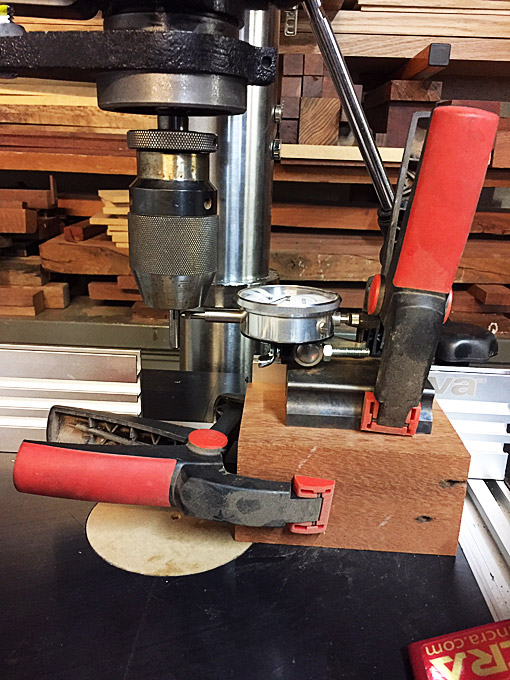
I used a 1/4" shank carbide router bit as the test piece. This was a one-time test, so I may have had better results from another router bit, or from re-positioning it. It is what it is ...

Results ...
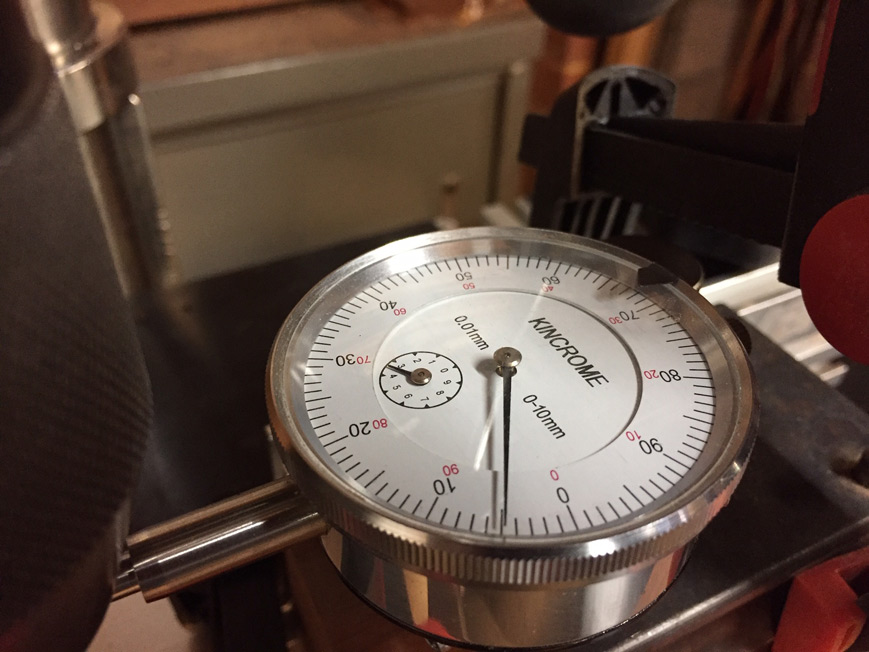
This reads 0.045mm run out. That is 0.0017" run out. Is that good or bad?
My understanding is: there is run out that may occur with the spindle, then there is run out that will occur at the chuck and quill (which could also be measured separately), and finally there is the run out measured at the bit. The results here are a total of all these together. It was mentioned to me that around 5 thousands of an inch would be acceptable. I have 1 thousand inch.
The other item I attended to was to add a Wixey laser guide ...
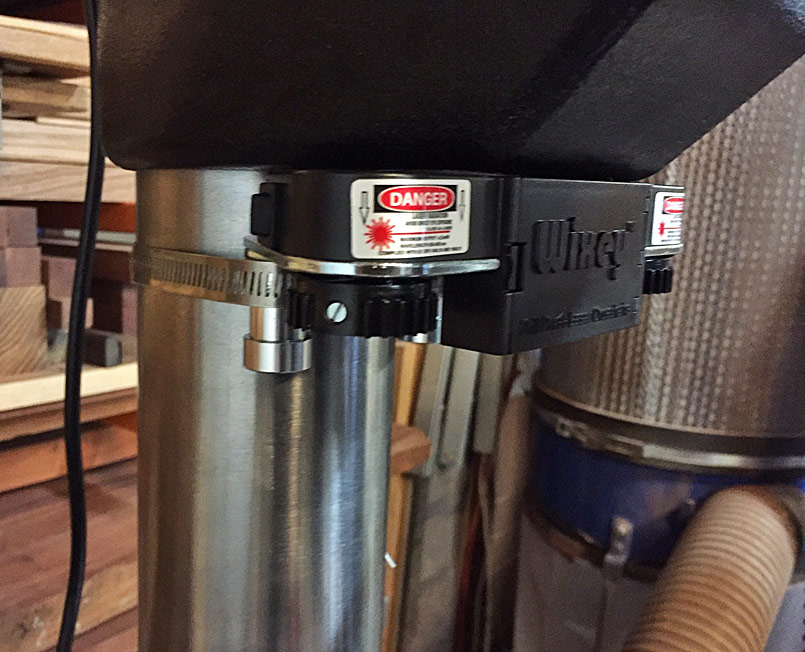
It tucks aware and is quite unobtrusive ...
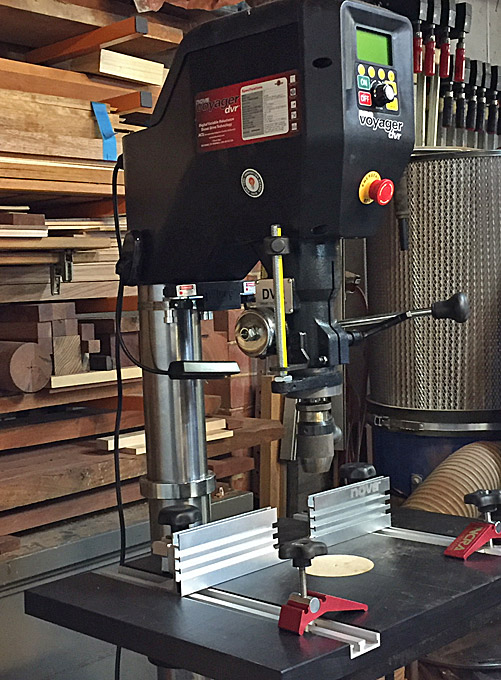
It leaves a nice, clean line ...
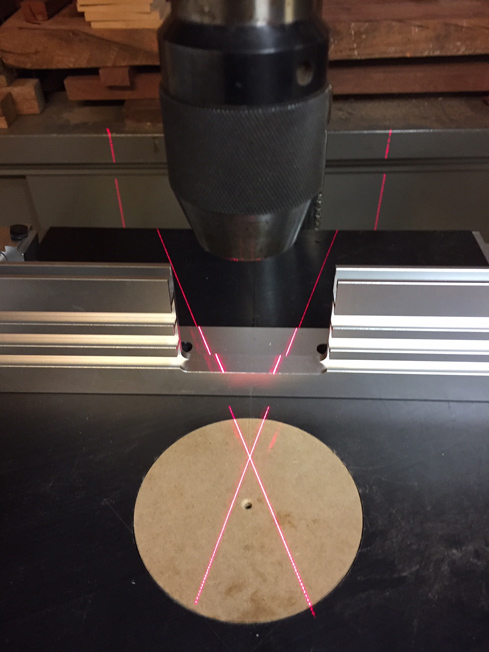
... but it is a little wider than expected. The jury is out whether it is just a gimmick, or whether it will prove to be useful.
Regards from Perth
DerekVisit www.inthewoodshop.com for tutorials on constructing handtools, handtool reviews, and my trials and tribulations with furniture builds.
-
14th December 2019, 09:06 PM #13

That's pretty good.

Considering the age of your chuck its better than I was expecting. I am guessing that if you were to measure the runout at the quill without the chuck it would be a lot less - as you would expect on a $3000 machine which makes a feature of minimum vibration.
I have the laser crosshairs on my drill press too. it has it's limitations but it is good for quickly getting the workpiece very close to where you want it but some fine tuning is often still required.I got sick of sitting around doing nothing - so I took up meditation.
-
14th December 2019, 10:07 PM #14
 .
.











- Join Date
- Feb 2006
- Location
- Perth
- Posts
- 27,790

DP run out is usually measured at the quill , 2 measurements are usually made, one with the quill fully retracted and one when fully extended
Chuck and chuck arbor runout is measured by holding a ground steel rod in the chuck and measuring the runout on the rod near the chuck jaws.as this takes into account deviations caused by the differences in the jaws. If you don’t have a ground steel rod then the shaft of a new ,quality drill bit is usually good enough. I would expect ~0.01 mm on the retracted quill of a new quality DP, and ~0.04 mm on the chuck provided it of of good quality.
FWIW One of my old 3 jaw keyed chuck (the one that came with the DP and has had a hard life) now has ~0.4 mm run out and it varies depending on which of the tightening holes I use and how many holes are used.
and it varies depending on which of the tightening holes I use and how many holes are used.
To get better chuck runout than these, metalwork gear normally uses “collet chucks”.
ADDITION
I went back and checked some DP run outs I measured earlier this year.
The DP Quill (fully retracted) runout is <0.005mm, can't find the fully extended measurement but from memory it was quite poor.
The old and battered keyed chuck I referred to above is between 0.4 and 0.65mm depending on which hole I use to tighten the chuck.
depending on which hole I use to tighten the chuck.
My best keyless chuck (I have 4 of them) is 0.03mm, and my worst is 0.56mm
ANOTHER ADDITION.
I dug out some more info on Jacobs" (a decent brand) chuck runout.
Their keyed plain bearing chucks only have a quoted runout of <0.1mm at half capacity.
Their ball bearing eyed chucks (usually considered superior) have a runout of <0.075 mm also at half capacity
They don't provide runouts for their keyless chucks.
A precision collet chuck will have a run out of <0.008m, non precision collet chucks have runouts of <0.015mm
Similar Threads
-
drill press table
By Avery in forum HOMEMADE TOOLS AND JIGS ETC.Replies: 5Last Post: 28th December 2011, 02:14 PM -
Drill press table
By I_wanna_Shed in forum HOMEMADE TOOLS AND JIGS ETC.Replies: 27Last Post: 17th August 2010, 09:27 PM -
Drill Press Table
By one day soon in forum HOMEMADE TOOLS AND JIGS ETC.Replies: 18Last Post: 7th May 2008, 11:43 PM -
Drill Press Table Kit
By spokeshave in forum GENERAL & SMALL MACHINERYReplies: 6Last Post: 17th January 2007, 10:19 PM -
Drill Press Table
By rodm in forum HOMEMADE TOOLS AND JIGS ETC.Replies: 3Last Post: 4th September 2003, 12:07 AM



 Thanks:
Thanks:  Likes:
Likes:  Picture(s) thanks:
Picture(s) thanks: 
 Reply With Quote
Reply With Quote
